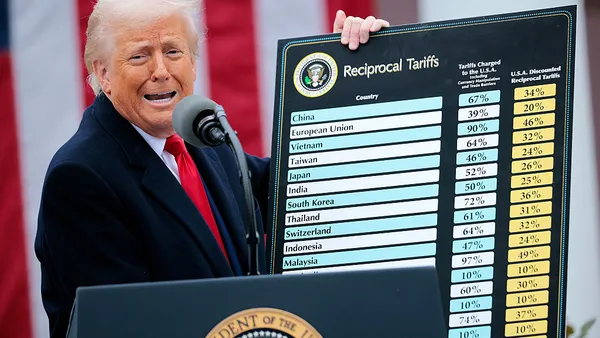"10 years' growth in 3 months." That was McKinsey's analysis of how COVID-19 changed e-commerce behavior in the U.S. in early 2020. The transformation of consumer shopping behavior hasn't slowed down and won't any time soon with the U.S. e-commerce market expected to grow 13.7% to $908.73 billion this year. Notably, this trend is not only domestic but global, with $4.2 trillion projected in e-commerce sales. With this eye-popping growth, it would be fair to ask, "Is this sustainable?"
Signals suggest that the answer is a resounding yes. Although many suspected these e-commerce spend levels were a byproduct of the COVID-19 era and that we might see a decline once we get past the pandemic, it appears that this may only be the start of e-commerce's ascent. Across consumer product categories, 15%-30% growth is expected after COVID-19 is defeated, and eMarketer forecasts that global e-commerce will reach $6 trillion by 2024. Clearly, consumers are more digitally fluent and ready to adopt this behavior than many believed.
However, many brands have been caught underprepared for this evolution and are now playing catch-up to support this wave of new e-commerce behavior, while other, digitally native brands actually gained a competitive advantage. Unfortunately, it's not just one channel or website update that's needed to compete. Nearly every touchpoint a brand has access to, from their owned website to social media channels to retailer product pages to influencer campaigns and more, is quickly being made shoppable. For most brands, it can be hard to solidify and support one channel effectively, let alone all of them.
With all this fragmentation and innovation swirling within the e-commerce space, it can feel overwhelming to navigate. Instead of jumping on every new commerce-enabled digital feature, brands would be well served to slow down and identify where best they can activate to drive the most value. This will require a considered assessment of their digital ecosystem and a deep understanding of their audience's behaviors and motivations.
The Shift From Journey Support to Experience Development
Too often marketers like to imagine consumers will fit into desired behavior loops and take action in a logical way. Unfortunately, reality has proven to be much more complex and difficult to predict. Google has recently dubbed the current consumer purchase process as "the messy middle," an apt descriptor for the way the traditional funnel has evolved. Beyond initial brand discovery, consumers are essentially in a constant state of consideration in which any aspect of a brand's marketing may help influence their shopper journey.
Successful e-commerce strategies require a shift in mindset from journey-based models to experience development. E-commerce experiences may happen on any channel at any time, but to be effective, they must be seamless and engaging for an audience. While every brand is going to execute their e-commerce strategies differently, the following four elements are helpful guiding principles to bear in mind.
- Make it Easy. When someone is ready to purchase a product online, the process needs to be simple and intuitive. Overcomplicating processes, asking for too much information, or even requiring too many clicks can lead to cart abandonment or, worse, consumer resentment.
- Make it Fast. In addition to making purchasing convenient, speed is a key factor. Everything from page speed to social ad CTAs to landing page strategy is important to make sure you are getting prospects to a destination where they can take action immediately.
- Make it Contextual. Being contextually relevant has proven itself an effective tool to drive brand engagement and sales, as well as improving lifetime value of customers. Leveraging data to bring this edge to e-commerce experiences can be a powerful yet subtle way to trim time from the consumer path to purchase while bolstering conversion rates. Whether it's deployed via ad targeting on social media or on an owned website to capture a user's location and automatically estimate shipping costs, a touch of contextualization can go a long way toward improving performance.
- Make it Relevant. Ensuring that your brand e-commerce experience reflects the audience you are marketing to should always be top of mind. This is easier said than done and can take many shapes. Your web and product design, purpose messaging, creative platform, and influencer strategy are just a few areas that need to be used in conjunction with e-commerce touchpoints to build connection with consumers and buoy their purchase confidence.
Although e-commerce presents a complex landscape for brands to get their arms around—especially legacy brands now finding themselves fighting for a share— it's an exciting and critical time to dive in. With unknown territory comes significant opportunity. Brands that meet the moment quickly enough will not only develop long-lasting competitive advantages, but gain an invaluable head start on the next decade (at least) of their marketing.
References:
- Bank of America. Forrester Analytics. ShawSpring Research. US Department of Commerce. McKinsey analysis. Available at: https://www.mckinsey.com/business-functions/strategy-and-corporate-finance/our-insights/five-fifty-the-quickening#
- Droesch B. US ecommerce by category 2021. Insider Intelligence/eMarketer. April 27, 2021. Available at: https://www.emarketer.com/content/us-ecommerce-by-category-2021
- Verdon J. Global e-commerce sales to hit $4.2 trillion as online surge continues, Adobe reports. Forbes. April 27, 2021. Available at: https://www.forbes.com/sites/joanverdon/2021/04/27/global-ecommerce-sales-to-hit-42-trillion-as-online-surge-continues-adobe-reports/
- Charm T, Coggins B, Robinson K, and Wilkie J. The great consumer shift: ten charts that show how US shopping behavior is changing. McKinsey & Company. August 4, 2020. Available at: https://www.mckinsey.com/business-functions/marketing-and-sales/our-insights/the-great-consumer-shift-ten-charts-that-show-how-us-shopping-behavior-is-changing#
- Worldwide ecommerce will approach $5 trillion this year. Insider Intelligence/eMarketer. January 14, 2021. Available at: https://www.emarketer.com/content/worldwide-ecommerce-will-approach-5-trillion-this-year
- Kaziukenas J. One year after Nike stopped selling on Amazon. TFL. October 28, 2020. Available at: https://www.thefashionlaw.com/one-year-after-nike-stopped-selling-on-amazon/
- Rennie A and Protheroe J. How people decide what to buy lies in the ‘messy middle’ of the purchase journey. Think with Google. July 2020. Available at: https://www.thinkwithgoogle.com/consumer-insights/consumer-journey/navigating-purchase-behavior-and-decision-making/










